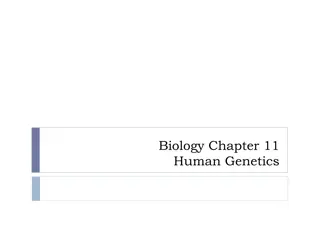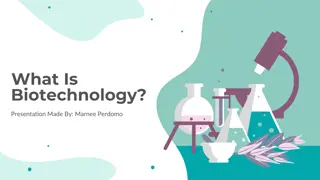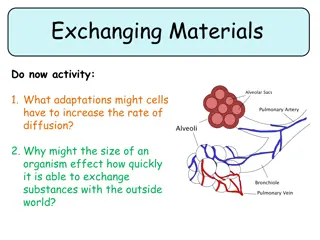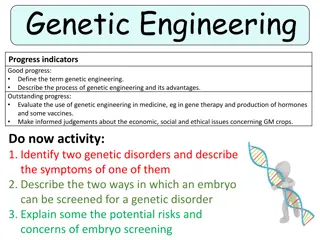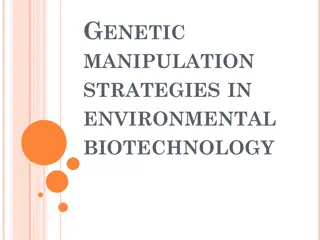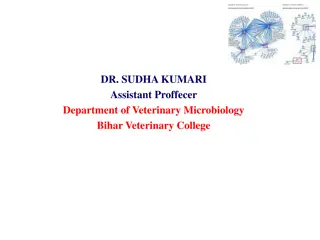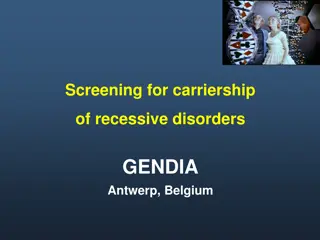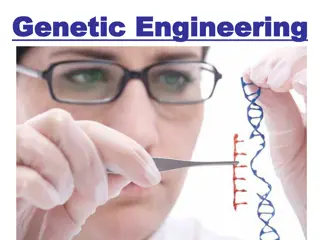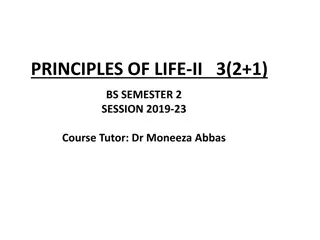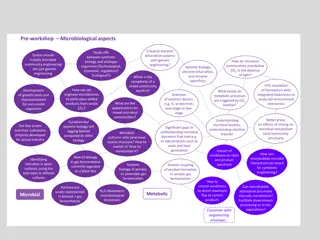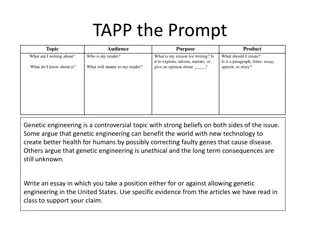Genetic Engineering: A Journey into Manipulating Organisms
Delve into the world of genetic engineering, where organisms' genetic makeup is altered for various purposes. Discover the process of modification, the history of genetic manipulation, and the impact of genetically modified organisms on society and science.
Download Presentation

Please find below an Image/Link to download the presentation.
The content on the website is provided AS IS for your information and personal use only. It may not be sold, licensed, or shared on other websites without obtaining consent from the author.If you encounter any issues during the download, it is possible that the publisher has removed the file from their server.
You are allowed to download the files provided on this website for personal or commercial use, subject to the condition that they are used lawfully. All files are the property of their respective owners.
The content on the website is provided AS IS for your information and personal use only. It may not be sold, licensed, or shared on other websites without obtaining consent from the author.
E N D
Presentation Transcript
Secondary Education Grade 11 Second Semester Eng. 202: New Language Leader Unit 9: Engineering ( Lesson 9.1 ) : From engine to engineer
By the end of this lesson, you will be able to: - create questions for a text. - write a short paragraph about the impact of engineering. Ministry of Education Second Semester 2020-2021 Eng 202 Lesson 9.1: Engineering
Introduction What are the types of engineering you know? Ministry of Education Second Semester 2020-2021 Eng. 202 Lesson 9.1: Engineering
Suggested Answer What are the types of engineering you know? 1- Chemical engineering. 2- Civil engineering. 3- Computer engineering. 4- Agricultural engineering. 5- Genetic engineering. 6- Electronic engineering. 7-Biological engineering. Ministry of Education Second Semester 2020-2021 Eng. 202 Lesson 9.1: Engineering
Read the text carefully, then fill in the blanks with the statements below. Task 1 In a field experiment in Cayman islands, this technique yielded about 85% reduction in the mosquito population in four months. Genetic engineering refers to a fast-growing technology that enables modifications in the genetic make up of an organism. Genetic engineering is the technique that gives the power to desirably manipulate the genome of an organism. What if this same mosquito is used to prevent the spread of diseases? Ministry of Education Second Semester 2020-2021 Eng. 202 Lesson 9.1: Engineering
TEXT Genetic Engineering 1 ----------------------------------------------------------------------------------------------------------- --------------------------------------------------. This ability has been explored and experimented in several organisms, some of which have been commercialized whereas the practical applications of some are being tested. The first genetically modified organism was created by Herbert Boyer and Stanley Cohen in 1973. It was the bacterium Escherichia coli that contained genes for antibiotic resistance. Ministry of Education Second Semester 2020-2021 Eng. 202 Lesson 9.1: Engineering
2 --------------------------------------------------------------------------------------------------------------- --------------------------------------------------------------------------. This includes addition of new gene(s), deletion of gene(s) or even manipulation of the existing genes to introduce or get rid of specific traits and characteristics. The resultant organisms, containing a genome altered in such a way, are collectively termed as genetically modified organisms (GMOs). In case of manipulation by addition of genes, the organisms which contain genes added from a different variety of the same species are called CIS genic organisms; whereas those containing genes from a foreign species are called transgenic organisms. Since the first successful attempt in 1973, several organisms were experimented with, giving rise to several interesting genetic engineering examples. One of the significant ones is described next. Ministry of Education Second Semester 2020-2021 Eng. 202 Lesson 9.1: Engineering
Disease - preventing mosquitoes Mosquito is considered to be the most dangerous insect. It has killed more humans than any other animal as well as killed more humans than even wars and plagues. --------------------------------------------------------------------------------- -------------------------------------------- Aedes aegypti is the mosquito species responsible for the spread of dengue, yellow fever, and chikungunya. An interesting fact about them is that only females can bite and thus transfer the virus. A single female lays about 500 eggs in her lifetime. On the other hand, the male mosquito cannot bite since it does not have the mouth parts for biting. The more important fact about this male is that it is exceptionally adept at finding the female mosquitoes. Taking advantage of these two properties, scientists at Oxford University developed a male mosquito that carries a gene which results in the death of its offspring. 3 Ministry of Education Second Semester 2020-2021 Eng. 202 Lesson 9.1: Engineering
4 ------------------------------------------------------------------------------------------------------- ---------------------------------------------------------------------------------------------------------- A production unit at Oxford is being developed to produce such mosquitoes on a larger scale with plans of producing about 20 million mosquitoes in a single week. Genetic engineering has opened up an array of approaches to tackle several challenges that are not just limited to the medical community. However, this technology has to cross several hurdles including safety concerns, stability of the resultant GMOs, transfer of genes into the wild, as well as ethical and social issues. Ministry of Education Second Semester 2020-2021 Eng. 202 Lesson 9.1: Engineering
MODEL ANSWERS Genetic Engineering 1 Genetic engineering is the technique that gives the power to desirably manipulate the genome of an organism. This ability has been explored and experimented in several organisms, some of which have been commercialized whereas the practical applications of some are being tested. The first genetically modified organism was created by Herbert Boyer and Stanley Cohen in 1973. It was the bacterium Escherichia coli that contained genes for antibiotic resistance. Ministry of Education Second Semester 2020-2021 Eng. 202 Lesson 9.1: Engineering
2 Genetic engineering refers to a fast-growing technology that enables modifications in the genetic make up of an organism. This includes addition of new gene(s), deletion of gene(s) or even manipulation of the existing genes to introduce or get rid of specific traits and characteristics. The resultant organisms, containing a genome altered in such a way, are collectively termed as genetically modified organisms (GMOs). In case of manipulation by addition of genes, the organisms which contain genes added from a different variety of the same species are called CIS genic organisms; whereas those containing genes from a foreign species are called transgenic organisms. Since the first successful attempt in 1973, several organisms were experimented with, giving rise to several interesting genetic engineering examples. One of the significant ones is described next. Ministry of Education Second Semester 2020-2021 Eng. 202 Lesson 9.1: Engineering
Disease - preventing mosquitoes Mosquito is considered to be the most dangerous insect. It has killed more humans than any other animal as well as killed more humans than even wars and plagues. What if this same mosquito is used to prevent the spread of diseases? Aedes aegypti is the mosquito species responsible for the spread of dengue, yellow fever, and chikungunya. An interesting fact about them is that only females can bite and thus transfer the virus. A single female lays about 500 eggs in her lifetime. On the other hand, the male mosquito cannot bite since it does not have the mouth parts for biting. The more important fact about this male is that it is exceptionally adept at finding the female mosquitoes. Taking advantage of these two properties, scientists at Oxford University developed a male mosquito that carries a gene which results in the death of its offspring. 3 Ministry of Education Second Semester 2020-2021 Eng. 202 Lesson 9.1: Engineering
4 In a field experiment in Cayman islands, this technique yielded about 85% reduction in the mosquito population in four months. A production unit at Oxford University is being developed to produce such mosquitoes on a larger scale with plans of producing about 20 million mosquitoes in a single week. Genetic engineering has opened up an array of approaches to tackle several challenges that are not just limited to the medical community. However, this technology has to cross several hurdles including safety concerns, stability of the resultant GMOs, transfer of genes into the wild, as well as ethical and social issues. Ministry of Education Second Semester 2020-2021 Eng. 202 Lesson 9.1: Engineering
Task 2: Write questions for these answers. A production unit at Oxford is being developed to produce such mosquitoes on a larger scale with plans of producing about 20 million mosquitoes in a single week. 4 1 The first genetically modified organism was created by Herbert Boyer and Stanley Cohen in 1973. The organisms that contain genes added from a different variety of the same species are called CIS genic organisms. 2 The male mosquito can not bite since it does not have the mouth parts for biting. A--------------------------------------------------------- 3 B--------------------------------------------------------- C-------------------------------------------------------- D-------------------------------------------------------- Ministry of Education Second Semester 2020-2021 Eng. 202 Lesson 9.1: Engineering
MODEL ANSWERS / Task 2 : Write questions for these answers. A production unit at Oxford University is being developed mosquitoes on a larger scale with plans of producing about 20 million mosquitoes in a single week. 4 1 The first genetically modified organism was created by Herbert Boyer and Stanley Cohen in 1973. to produce such The organisms that contain genes added from a different variety of the same species are called CIS genic organisms. 2 The male mosquito can not bite since it does not have the mouth parts for biting. A-When was the first genetically modified organism created? 3 B-What is the name of the organisms which contain genes added from a different variety of the same species? C- Why is the male mosquito unable to bite? D-How many mosquitoes is the production unit expected to produce per week? Ministry of Education Second Semester 2020-2021 Eng. 202 Lesson 9.1: Engineering
Assessment What do these numbers refer to? Try to recall the information in the text that you have just read. 20,000,000 ------------------------------------ 500 ------------------------------------ 85% ------------------------------------ 1973 ------------------------------------ Ministry of Education Second Semester 2020-2021 Eng. 202 Lesson 9.1: Engineering
What do these numbers refer to? Try to recall the information in the text that you have just read. Model Answers 20,000,000 The target number of mosquitoes to be produced every week by a production unit at Oxford University. 500 The number of eggs a single female lays in her lifetime. 85% The percentage of reduction in the mosquito population in four months. 1973 The year in which the first genetically modified organism was created by Herbert Boyer and Stanley Cohen in 1973 Ministry of Education Second Semester 2020-2021 Eng. 202 Lesson 9.1: Engineering
Writing Write a short paragraph about how has engineering improved people s lives in one of these sectors, health, communication, or technology. ------------------------------------------------------------------------------------ ------------------------------------------------------------------------------------ ------------------------------------------------------------------------------------ ------------------------------------------------------------------------------------ ------------------------------------------------------------------------------------ ------------------------------------------------------------------------------------ ------------------------------------------------------------------------------------ Ministry of Education Second Semester 2020-2021 Eng. 202 Lesson 9.1: Engineering
Model Writing The Impact of Engineering on Communication Engineering has improved communication in different ways. To start with, the improvement in telecommunications has resulted in a better quality of life. For instance, Satellite TV, cell phones, computers and the internet have enabled us to be instantly informed about what is taking place around the world. Additionally, thanks to engineers and their amazing inventions, one can easily communicate with their friends, family members or colleagues at work wherever they are at a very low cost. Last but not least, engineering has greatly improved the way businesses can communicate with their customers. It has opened up new horizons for companies to ameliorate their marketing policies, be close to their clients and up-to-date them of any new products or offers. All in all, engineering has played a key role in connecting the world and making it a better place to live. Ministry of Education Second Semester 2020-2021 Eng. 202 Lesson 9.1: Engineering
This is the end of the lesson. THANK YOU FOR YOUR ATTENTION Ministry of Education Second Semester 2020-2021 Eng. 202 Lesson 9.1: Engineering







